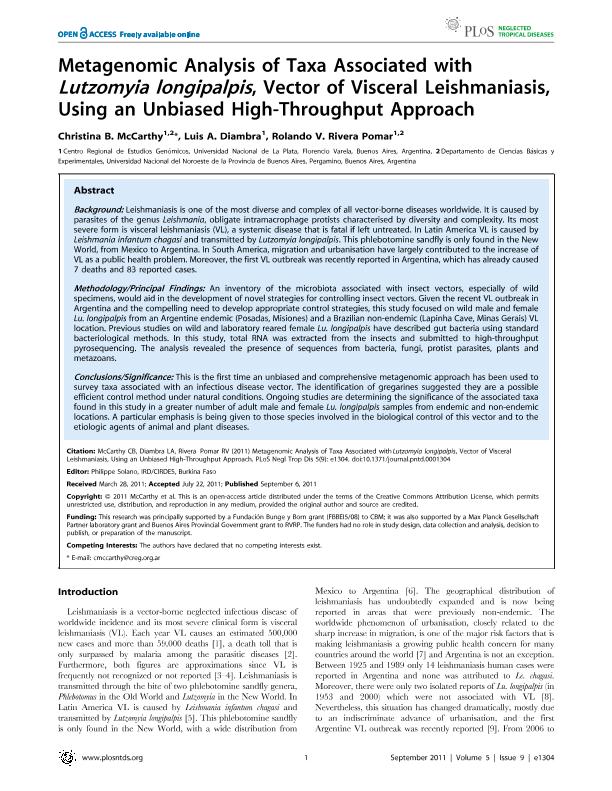Mostrar el registro sencillo del ítem
dc.contributor.author
Mccarthy, Cristina Beryl

dc.contributor.author
Diambra, Luis Anibal

dc.contributor.author
Rivera Pomar, Rolando

dc.date.available
2020-01-23T22:17:39Z
dc.date.issued
2011-09
dc.identifier.citation
Mccarthy, Cristina Beryl; Diambra, Luis Anibal; Rivera Pomar, Rolando; Metagenomic Analysis of Taxa Associated with Lutzomyia longipalpis, Vector of Visceral Leishmaniasis, Using an Unbiased High-Throughput Approach; Public Library of Science; Neglected Tropical Diseases; 5; 9; 9-2011; 1-10
dc.identifier.issn
1935-2735
dc.identifier.uri
http://hdl.handle.net/11336/95763
dc.description.abstract
Background: Leishmaniasis is one of the most diverse and complex of all vector-borne diseases worldwide. It is caused by parasites of the genus Leishmania, obligate intramacrophage protists characterised by diversity and complexity. Its most severe form is visceral leishmaniasis (VL), a systemic disease that is fatal if left untreated. In Latin America VL is caused by Leishmania infantum chagasi and transmitted by Lutzomyia longipalpis. This phlebotomine sandfly is only found in the New World, from Mexico to Argentina. In South America, migration and urbanisation have largely contributed to the increase of VL as a public health problem. Moreover, the first VL outbreak was recently reported in Argentina, which has already caused 7 deaths and 83 reported cases. Methodology/Principal Findings: An inventory of the microbiota associated with insect vectors, especially of wild specimens, would aid in the development of novel strategies for controlling insect vectors. Given the recent VL outbreak in Argentina and the compelling need to develop appropriate control strategies, this study focused on wild male and female Lu. longipalpis from an Argentine endemic (Posadas, Misiones) and a Brazilian non-endemic (Lapinha Cave, Minas Gerais) VL location. Previous studies on wild and laboratory reared female Lu. longipalpis have described gut bacteria using standard bacteriological methods. In this study, total RNA was extracted from the insects and submitted to high-throughput pyrosequencing. The analysis revealed the presence of sequences from bacteria, fungi, protist parasites, plants and metazoans. Conclusions/Significance: This is the first time an unbiased and comprehensive metagenomic approach has been used to survey taxa associated with an infectious disease vector. The identification of gregarines suggested they are a possible efficient control method under natural conditions. Ongoing studies are determining the significance of the associated taxa found in this study in a greater number of adult male and female Lu. longipalpis samples from endemic and non-endemic locations. A particular emphasis is being given to those species involved in the biological control of this vector and to the etiologic agents of animal and plant diseases.
dc.format
application/pdf
dc.language.iso
eng
dc.publisher
Public Library of Science

dc.rights
info:eu-repo/semantics/openAccess
dc.rights.uri
https://creativecommons.org/licenses/by-nc-sa/2.5/ar/
dc.subject
LUTZOMYIA LONGIPALPIS
dc.subject
VISCERAL LEISHMANIASIS
dc.subject
METAGENOMICS
dc.subject
PYROSEQUENCING
dc.subject.classification
Otros Tópicos Biológicos

dc.subject.classification
Ciencias Biológicas

dc.subject.classification
CIENCIAS NATURALES Y EXACTAS

dc.title
Metagenomic Analysis of Taxa Associated with Lutzomyia longipalpis, Vector of Visceral Leishmaniasis, Using an Unbiased High-Throughput Approach
dc.type
info:eu-repo/semantics/article
dc.type
info:ar-repo/semantics/artículo
dc.type
info:eu-repo/semantics/publishedVersion
dc.date.updated
2020-01-22T19:59:40Z
dc.journal.volume
5
dc.journal.number
9
dc.journal.pagination
1-10
dc.journal.pais
Estados Unidos

dc.description.fil
Fil: Mccarthy, Cristina Beryl. Universidad Nacional de La Plata. Centro Regional de Estudios Genómicos; Argentina. Consejo Nacional de Investigaciones Científicas y Técnicas; Argentina. Universidad Nacional del Noroeste de la Provincia de Buenos Aires. Departamento de Ciencias Básicas y Experimentales; Argentina
dc.description.fil
Fil: Diambra, Luis Anibal. Universidad Nacional de La Plata. Centro Regional de Estudios Genómicos; Argentina. Consejo Nacional de Investigaciones Científicas y Técnicas; Argentina
dc.description.fil
Fil: Rivera Pomar, Rolando. Universidad Nacional del Noroeste de la Provincia de Buenos Aires. Departamento de Ciencias Básicas y Experimentales; Argentina. Universidad Nacional de La Plata. Centro Regional de Estudios Genómicos; Argentina. Consejo Nacional de Investigaciones Científicas y Técnicas; Argentina
dc.journal.title
Neglected Tropical Diseases

dc.relation.alternativeid
info:eu-repo/semantics/altIdentifier/url/https://journals.plos.org/plosntds/article?id=10.1371/journal.pntd.0001304
dc.relation.alternativeid
info:eu-repo/semantics/altIdentifier/doi/http://dx.doi.org/10.1371/journal.pntd.0001304
Archivos asociados
